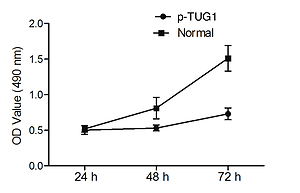Current issue
Archive
Manuscripts accepted
About the Journal
Editorial office
Editorial board
Section Editors
Abstracting and indexing
Subscription
Contact
Ethical standards and procedures
Most read articles
Instructions for authors
Article Processing Charge (APC)
Regulations of paying article processing charge (APC)
GASTROENTEROLOGY / EXPERIMENTAL RESEARCH
TUG1 acts as a biomarker to predict the relapse of gastric cancer after endoscopic submucosal dissection
1
Department of Gastroenterology, The First People’s Hospital of Yancheng, Yancheng, Jiangsu, China
Submission date: 2019-07-30
Final revision date: 2020-01-30
Acceptance date: 2020-03-11
Online publication date: 2021-03-28
Corresponding author
Yanping Hao
Department of Gastroenterology, The First People’s Hospital of Yancheng, No.66 Renmin Road, Yancheng, Jiangsu 224005, China
Department of Gastroenterology, The First People’s Hospital of Yancheng, No.66 Renmin Road, Yancheng, Jiangsu 224005, China
KEYWORDS
TOPICS
ABSTRACT
Introduction:
MiR-382 was reported to act as a prognostic biomarker for the relapse of gastric cancer (GC) after endoscopic mucosal resection (EMR). In addition, TUG1 was reported to regulate cell proliferation via sponging miR-382. Therefore, in this study, we aimed to investigate the value of TUG1 in predicting post-EMR relapse of GC.
Material and methods:
The log rank test was utilized to analyze relapse-free rate and validate the prognostic value of TUG1 in predicting post-EMR GC relapse. Real-time PCR, Western blot and luciferase assays were performed to clarify the regulatory relationships among TUG1, miR-382 and CD44, thus establishing a TUG1/miR-382/CD44 signaling pathway. Moreover, MTT assays were conducted to observe the effect of TUG1 on cell proliferation and post-EMR GC relapse.
Results:
The AUC of the high TUG1 expression group was obviously smaller than that of the low TUG1 expression group, which indicated that the expression of TUG1 could be used as a prognostic biomarker to predict the risk of post-EMR GC relapse. In addition, a negative correlation was found between miR-382 expression and the expression of its endogenous competing RNA TUG1. Furthermore, miR-382 was shown to inhibit the expression of its target gene CD44. Finally, a TUG1/miR-382/CD44 signaling pathway was established and was implicated in post-EMR recurrence of GC, and the overexpression of TUG1 was shown to promote the proliferation of GC cells.
Conclusions:
Reduced expression of TUG1 could inhibit the proliferation of GC cells and increase the expression of miR-382, which in turn down-regulated CD44 expression and lowered the risk of post-EMR GC relapse.
MiR-382 was reported to act as a prognostic biomarker for the relapse of gastric cancer (GC) after endoscopic mucosal resection (EMR). In addition, TUG1 was reported to regulate cell proliferation via sponging miR-382. Therefore, in this study, we aimed to investigate the value of TUG1 in predicting post-EMR relapse of GC.
Material and methods:
The log rank test was utilized to analyze relapse-free rate and validate the prognostic value of TUG1 in predicting post-EMR GC relapse. Real-time PCR, Western blot and luciferase assays were performed to clarify the regulatory relationships among TUG1, miR-382 and CD44, thus establishing a TUG1/miR-382/CD44 signaling pathway. Moreover, MTT assays were conducted to observe the effect of TUG1 on cell proliferation and post-EMR GC relapse.
Results:
The AUC of the high TUG1 expression group was obviously smaller than that of the low TUG1 expression group, which indicated that the expression of TUG1 could be used as a prognostic biomarker to predict the risk of post-EMR GC relapse. In addition, a negative correlation was found between miR-382 expression and the expression of its endogenous competing RNA TUG1. Furthermore, miR-382 was shown to inhibit the expression of its target gene CD44. Finally, a TUG1/miR-382/CD44 signaling pathway was established and was implicated in post-EMR recurrence of GC, and the overexpression of TUG1 was shown to promote the proliferation of GC cells.
Conclusions:
Reduced expression of TUG1 could inhibit the proliferation of GC cells and increase the expression of miR-382, which in turn down-regulated CD44 expression and lowered the risk of post-EMR GC relapse.
Share
RELATED ARTICLE
We process personal data collected when visiting the website. The function of obtaining information about users and their behavior is carried out by voluntarily entered information in forms and saving cookies in end devices. Data, including cookies, are used to provide services, improve the user experience and to analyze the traffic in accordance with the Privacy policy. Data are also collected and processed by Google Analytics tool (more).
You can change cookies settings in your browser. Restricted use of cookies in the browser configuration may affect some functionalities of the website.
You can change cookies settings in your browser. Restricted use of cookies in the browser configuration may affect some functionalities of the website.



